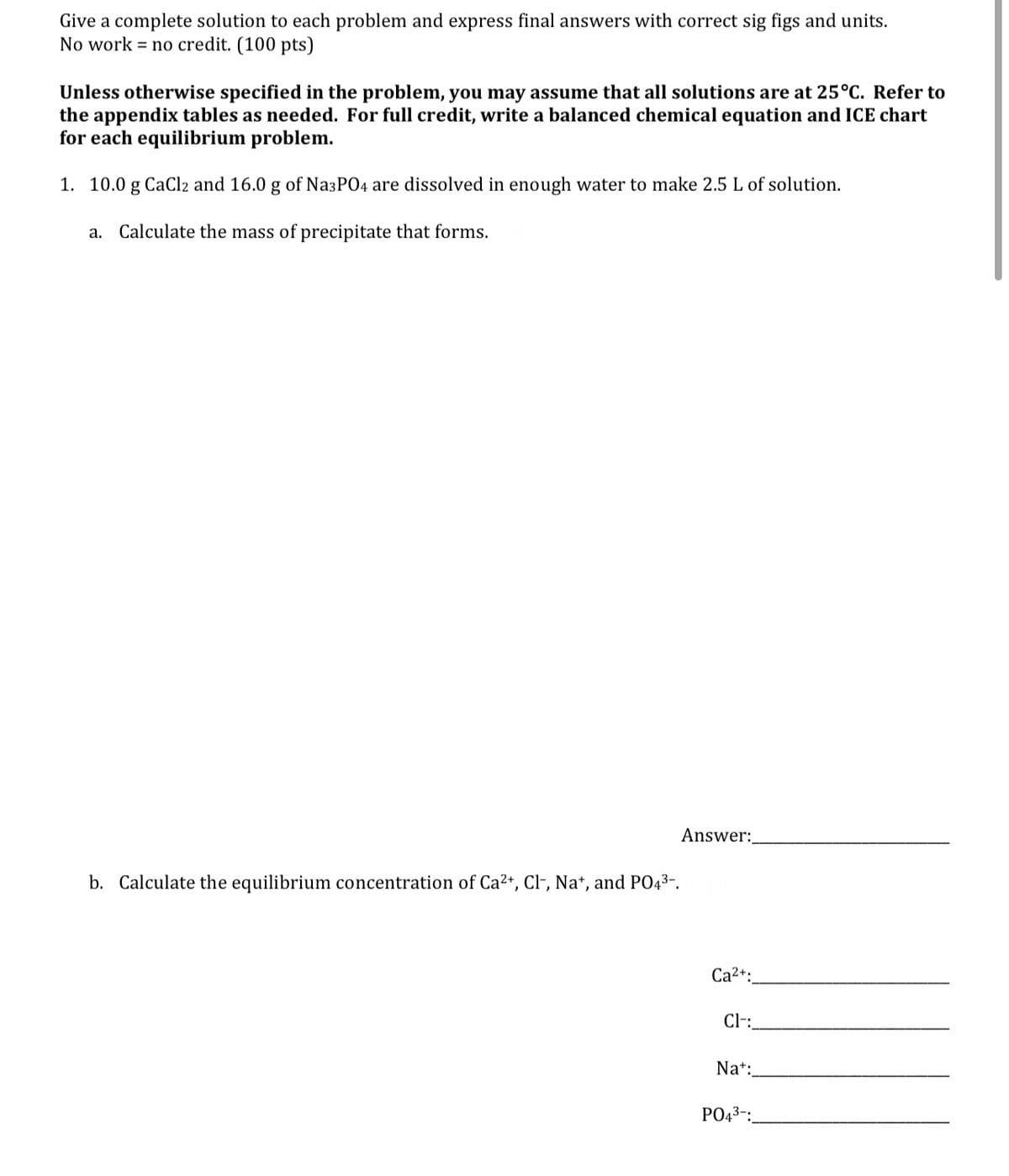Give a complete solution to each problem and express final answers with correct sig figs and units. No work no credit. (100 pts) Unless otherwise specified in the problem, you may assume that all solutions are at 25°C. Refer to the appendix tables as needed. For full credit, write a balanced chemical equation and ICE chart for each equilibrium problem. 1. 10.0 g CaCl2 and 16.0 g of Na3PO4 are dissolved in enough water to make 2.5 L of solution. a. Calculate the mass of precipitate that forms. Answer: b. Calculate the equilibrium concentration of Ca²+, Cl-, Na+, and PO4³-. Ca2+: CI-: Nat: PO43-
Give a complete solution to each problem and express final answers with correct sig figs and units. No work no credit. (100 pts) Unless otherwise specified in the problem, you may assume that all solutions are at 25°C. Refer to the appendix tables as needed. For full credit, write a balanced chemical equation and ICE chart for each equilibrium problem. 1. 10.0 g CaCl2 and 16.0 g of Na3PO4 are dissolved in enough water to make 2.5 L of solution. a. Calculate the mass of precipitate that forms. Answer: b. Calculate the equilibrium concentration of Ca²+, Cl-, Na+, and PO4³-. Ca2+: CI-: Nat: PO43-
Chemistry: The Molecular Science
5th Edition
ISBN:9781285199047
Author:John W. Moore, Conrad L. Stanitski
Publisher:John W. Moore, Conrad L. Stanitski
Chapter12: Chemical Equilibrium
Section: Chapter Questions
Problem 6QRT: Indicate whether each statement below is true or false. If a statement is false, rewrite it to...
Related questions
Question
Question 1

Transcribed Image Text:Give a complete solution to each problem and express final answers with correct sig figs and units.
No work no credit. (100 pts)
Unless otherwise specified in the problem, you may assume that all solutions are at 25°C. Refer to
the appendix tables as needed. For full credit, write a balanced chemical equation and ICE chart
for each equilibrium problem.
1. 10.0 g CaCl2 and 16.0 g of Na3PO4 are dissolved in enough water to make 2.5 L of solution.
a. Calculate the mass of precipitate that forms.
Answer:
b. Calculate the equilibrium concentration of Ca²+, Cl-, Na+, and PO4³-.
Ca²+:
Cl-:
Nat:
PO43-
Expert Solution
This question has been solved!
Explore an expertly crafted, step-by-step solution for a thorough understanding of key concepts.
Step by step
Solved in 2 steps with 2 images

Knowledge Booster
Learn more about
Need a deep-dive on the concept behind this application? Look no further. Learn more about this topic, chemistry and related others by exploring similar questions and additional content below.Recommended textbooks for you

Chemistry: The Molecular Science
Chemistry
ISBN:
9781285199047
Author:
John W. Moore, Conrad L. Stanitski
Publisher:
Cengage Learning

Chemistry & Chemical Reactivity
Chemistry
ISBN:
9781337399074
Author:
John C. Kotz, Paul M. Treichel, John Townsend, David Treichel
Publisher:
Cengage Learning

Chemistry for Engineering Students
Chemistry
ISBN:
9781337398909
Author:
Lawrence S. Brown, Tom Holme
Publisher:
Cengage Learning

Chemistry: The Molecular Science
Chemistry
ISBN:
9781285199047
Author:
John W. Moore, Conrad L. Stanitski
Publisher:
Cengage Learning

Chemistry & Chemical Reactivity
Chemistry
ISBN:
9781337399074
Author:
John C. Kotz, Paul M. Treichel, John Townsend, David Treichel
Publisher:
Cengage Learning

Chemistry for Engineering Students
Chemistry
ISBN:
9781337398909
Author:
Lawrence S. Brown, Tom Holme
Publisher:
Cengage Learning

Chemistry: Principles and Reactions
Chemistry
ISBN:
9781305079373
Author:
William L. Masterton, Cecile N. Hurley
Publisher:
Cengage Learning


Chemistry: An Atoms First Approach
Chemistry
ISBN:
9781305079243
Author:
Steven S. Zumdahl, Susan A. Zumdahl
Publisher:
Cengage Learning